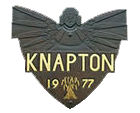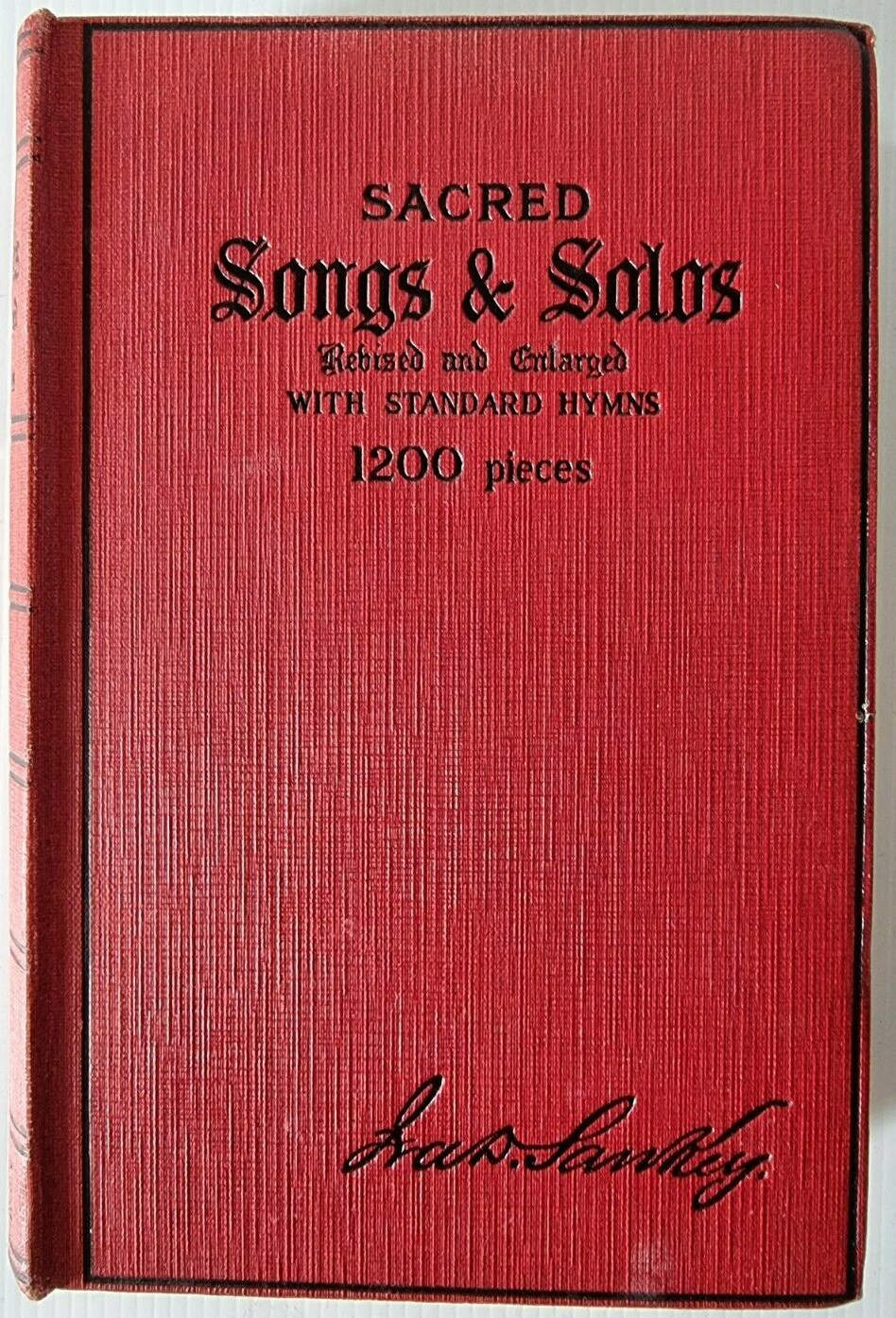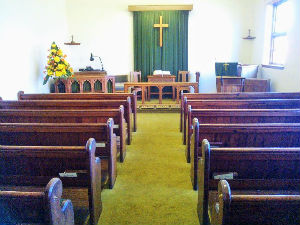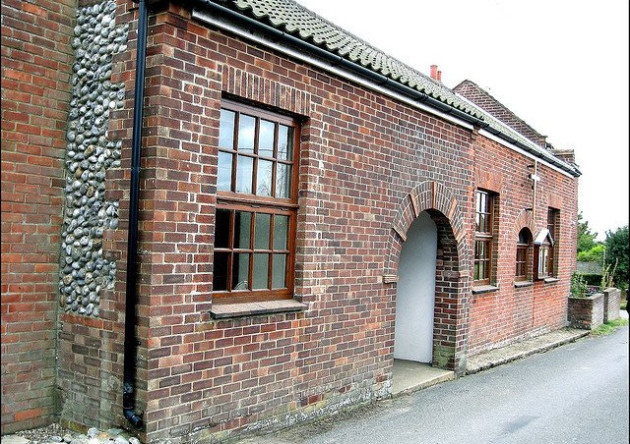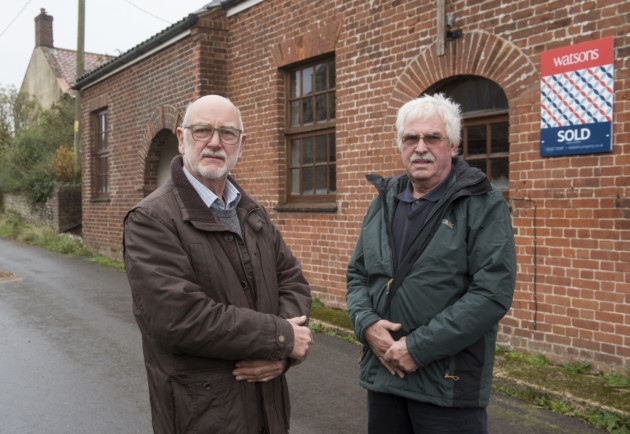100 Years of Methodism in Knapton – 1890 to 2016
A Short History compiled by Herbert S. Hicks
The Methodist Church in Knapton began in a barn which formed part of a small holding and was adjoined to a farm cottage. For a time the barn was used for a carpenter’s shop.
In 1880 a retired minister, Rev. E.S. Shields, bought the building and adjoining cottage. He came to live in the cottage, turning the barn into a chapel. He made a connecting doorway and had the place registered for worship: licence No. 25155.
We have no record of what happened in the next ten years but in 1890 the North Walsham Primitive Methodist Circuit hired the buildings and the minister, Rev. I Buck, began organising services. A rent of £2 per year was paid and the circuit contributed 15/- per quarter to help the society get started:
In 1896 Rev. G.W. Hancock became minister. The records show that coal was 1/2d per cwt, oil for the lamps was 9d per gallon and there was an open fire-place in the south wall.
Curiously, it appears that services were discontinued in 1902, but someone carried on paying the rent…
In 1916 the chapel re-opened. A new head teacher by the name of Miss Carpenter came to the school house with her mother and they were keen to have services re-started. Also a Mr Scott came to lodge in the village. He was a non-conformist and he offered to be treasurer and the Rev. Joshua Biggs was now minister.
The tile brick floor was scrubbed, the walls whitewashed, the windows painted, new matting was put in, the organ was tuned and a new notice board fitted.
And a new Sankey hymn book bought (possibly similar to the one on the right)
Special services were arranged for the opening day, with teas provided which all paid off because the collections and tea brought in £111.15.0.
1921 was a very exciting year – the property, including the cottage, came up for sale and many events were arranged to raise the money. A great event called a “Sale of Work” was put on on the meadow, now called Lawn Close. The ladies had stalls of garments, home-made jams, etc. and the men brought gifts from their allotments. Many local chapels were supportive, including Trunch (I came with my mother. I was 8 years old) and it was a wonderful success. £70 was raised.
It’s worth noting that a Sunday collection at about this time was 1/6d in the afternoon and 1/10d in the evening.
The society bought it for £165. Rev. H. Bennett (superintendent minister) loaned half the money @ 5% interest.
The annual income from the cottage was 2/3d per quarter and the property was insured for 3/6d per year.
In the next few years several special services were arranged including Services of Song, Musical Evenings, Lantern Lectures, Entertainments, Tea Meetings, etc. Among those who came to help were the Trunch Christian Endeavour, Mundesley Wesleyans, Roughton Primitives, Mundesley Free Church, Witton Primitives, North Walsham Salvation Army, Paston Chapel, and North Walsham Wesleyans.
In 1923 a new pulpit Bible was bought for £5 (around £322 in today’s money). More improvements were made to the building including a wooden porch built inside the west wall, a wooden floor was laid and a tortoise stove placed in the centre of the chapel. A new hymn board was also made.
Mrs Carpenter died in 1930. Her daughter, the Knapton School head teacher, with other members had a plate of remembrance placed on the east wall. It included several who had passed on to their reward during the previous few years: Georgina Wright, J.W. Scott, John Roberts, Janet Carpenter, William Watts and Philip Appleton.
By 1935 Knapton Methodists were able to contribute a little to the circuit (12 per quarter), as well as paying £5 per year off the loan.
In 1937 I married a Knapton member and came to live in the village. The Knapton Chapel was not then licensed for marriages. So we were married at the Wesleyan Chapel at Trunch by Rev. T. Featherstone. The new chapel at Trunch was being built, but was not complete.
I then transferred my membership from Trunch to Knapton, and Mr Featherstone asked me to become Trust treasurer and Sunday School superintendent. At that time there were five scholars and seven chapel members. There were no trustees living in Knapton. Most of the few still living were in North Walsham. Owing to the war none were present for the first three yearly meetings.
1944 brought many changes. The existing porch was built, the doorway to the adjoining cottage blocked off and the inside wooden porch removed. At the disposal of the Trimingham Chapel, Knapton bought the seats. The pulpit was bought and given by two devoted members, Mr & Mrs James Bowman. The tortoise stove was removed and the seats fixed in place. Up to this time the seating arrangements consisted of four chairs, making up the front row, and five rows of wooden forms. These forms had one rail running along the back, so if you were very short or went to sleep you could fall through. A new entrance was built, with a brick arch. Owing to bomb damage during the war years the government paid out 8/- per year for five years.
A new trust was formed in 1945 which included more local persons who were able to give better support and guidance.
About 1946 the Y.L.L. (Young Laymen’s League) gave some special evening services. One of the results was that a newlywed young man became a member. For many years he and his wife, Mr & Mrs James Steward, were a great blessing. They brought all their family through the chapel and many of them still serve in other churches.
In 1947 electricity was installed, costing £17.
In 1951 the water was laid on.
In 1955 we suffered the loss of a very gifted member, Mrs Iris Fawkes. Married in the chapel, she died at the age of only 23 years. Iris’s former name was Carr. She had come through the Sunday School and become a teacher, serving also as President of the Women’s Own, secretary to the Circuit Youth Council, and secretary to the Circuit Eisteddfod. Her husband presented an oak table, two chairs and the oak communion rail in her memory.
In 1960 the new schoolroom was build, where an old cart shed and stable had stood. (preachers no longer came by horse and trap.)
In 1964 an electric organ was purchased and in 1970 money was raised to buy a new oak pulpit to replace the old worm-eaten pine one which was put in a corner position.
A cross on the wall was given central place and Miss Mackenzie presented an oak screen in memory of her father, Rev. F. Mackenzie, matching the communion rail, to screen the organ.
This completed the lay-out of the front of the church.
By 1979 the congregation had increased and the schoolroom was very much used by youth activities, committee meetings, Women’s Own, Parish Council, Men’s Fellowship, Parish Church Council meetings, etc. so it was felt that a kitchen and toilet were badly needed. We had no land around our buildings, but Mr & Mrs Hammond, local farmers, offered us, for a nominal fee, a small part of a garden from his cottage land adjoining our schoolroom at the north end of the chapel.
We were very grateful for this kind gesture and began to plan ways and means to build. It was estimated that the cost would be around £10,000 and fortunately we still owned the cottage at the south end of the chapel. It was in a deplorable condition and had been empty for some years so we decided to sell it and use the proceeds of sale. It made £6000. To our delight it was bought by a young Methodist minister, Rev. L. Osborn, and his wife.
About this time we experienced some very severe weather. Water and snow came through the chapel roof and flooded the floor. The roof had to be re-tiled, the walls redecorated, and new carpet laid. Fortunately the insurance company shared the costs. This task completed, we focused our attention on building the kitchen and toilet. The project was finished in 1985 and we now find it most useful.
We have a very happy, loving fellowship our society today. There are twenty four members, six under 20 years old. There are fifteen children, Women’s Own has 25 members, and Ken’s Fellowship fifteen members. We have a monthly Prayer Circle, and regular united worship and other shared activities with our friends in the Parish Church.
We praise God for all that is past and trust that the future may be fruitful and bring glory to His Name.
Addendum – 2013
A would-be thief trying to steal just one metre of copper piping could have caused wide-scale death and devastation in a north Norfolk village, according to a church minister. The vandal’s botched overnight bid to get at the metal ruptured a pipe, completely filling Knapton Methodist Chapel and its surrounding area with gas. The potential disaster was not discovered until yesterday morning when a quick-thinking neighbour switched off the supply and raised the alarm.
Methodist minister the Rev Sharon Willimott said that when a National Grid engineer had arrived to make the area safe, he had told her the consequences could have been “completely catastrophic” as the building is sited in the middle of the small village, near North Walsham. She added: “If it had gone up, it would have destroyed the chapel, the cottage next door, the home behind, the bungalows, and it would probably have also damaged the parish church – the loss of life could have been terrible.”
Chapel chiefs believe someone tried to rip the piping off between 8pm on Tuesday and 7.30am yesterday when dog walker Alan Leedham passed the chapel, smelled gas and rushed to his home in the village to get his own gas meter cupboard key. Mr Leedham had come across another resident, Fred Winter, en route and Mr Winter had given him his key which he used to open the meter cupboard on the external chapel wall and turn the lever, cutting the gas supply.
Mrs Willimott said the chapel was used by the community and if a group had been going to use it yesterday, the automatic heating system could have activated. “It just doesn’t bear thinking about,” she said. “I had wondered whether a car had accidentally knocked the pipe in passing but it’s recessed. Someone has deliberately done this. These people can’t really comprehend what they are doing. They are very selfish and greedy but I can’t believe they have got such a complete disregard for life.”
Now the chapel, with an average congregation of 20, faced the prospect of a mammoth gas bill, possibly running into hundreds of pounds, she added. “We don’t know how long the gas was escaping. We will be talking to our suppliers to see what can be done. I think the community will rally round.”
Addendum – 2016 onwards…
Chapel Closed
The congregation numbers were dwindling and eventually the chapel fellowship took the brave decision to cease worshipping from the chapel and put it up for sale. The last service held in the chapel was led by Revd Leo Osborn, a past President of the Methodist Church, on January 10th 2015 at 4pm.
You can read / download the text of that final sermon by clicking on the link on the right.
Chapel Sold
Knapton Parish Council had offered more than £2,500 above the £65,000 guide price to buy the Methodist chapel on the village’s Pond Lane, explaining to a Methodist chief that it wanted to buy the chapel and use it as a village hall, according to parish council Vice Chairman Alan Young.
But Mr Young said he had discovered that the Methodists had accepted an offer from an unidentified bidder instead. “I’m very disappointed on behalf of the village,” said Mr Young. “The village built and maintained it through the years. It was even extended about 25-30 years ago using land donated by the local Hammond farming family,” said Mr Young, “I think the Methodists have behaved poorly over the whole deal. If they really cared for the community they would have let the parish council buy it – it’s not very Christian of them. They weren’t obliged to accept the highest offer and it wasn’t as if were asking them to give it to us for nothing.”
Knapton used a Victorian building belonging to the Church of England as its village hall. It was in a poor state of repair, with a roof which was “falling in”, and needed about £150,000 spent on improvements, said Mr Young. By contrast the chapel was “in good nick”, with a toilet, kitchen and large room which could be divided. “It would have been ideal,” he added.
Cedric Brown, a member of the Methodist Church who was asked by the North Norfolk Methodist Circuit to organise the chapel’s sale, said the building had been sold for “a considerably larger amount” than the parish council had offered. The sale, for which sealed bids were invited, had attracted a number of offers but he declined to say who had bought it or how much they had paid.
“The church is a charity and it’s obliged to get a certificate showing that the amount accepted was the best price reasonably obtainable,” he said, adding “I’m sorry that the parish council was not able to make an offer that would enable the sale to them to take place.”
Vice Chairman Alan Young and Councillor Andrew Claydon
Knapton used a Victorian building belonging to the Church of England as its village hall. It was in a poor state of repair, with a roof which was “falling in”, and needed about £150,000 spent on improvements, said Mr Young. By contrast the chapel was “in good nick”, with a toilet, kitchen and large room which could be divided. “It would have been ideal,” he added.
Cedric Brown, a member of the Methodist Church who was asked by the North Norfolk Methodist Circuit to organise the chapel’s sale, said the building had been sold for “a considerably larger amount” than the parish council had offered. The sale, for which sealed bids were invited, had attracted a number of offers but he declined to say who had bought it or how much they had paid.
“The church is a charity and it’s obliged to get a certificate showing that the amount accepted was the best price reasonably obtainable,” he said, adding “I’m sorry that the parish council was not able to make an offer that would enable the sale to them to take place.”
